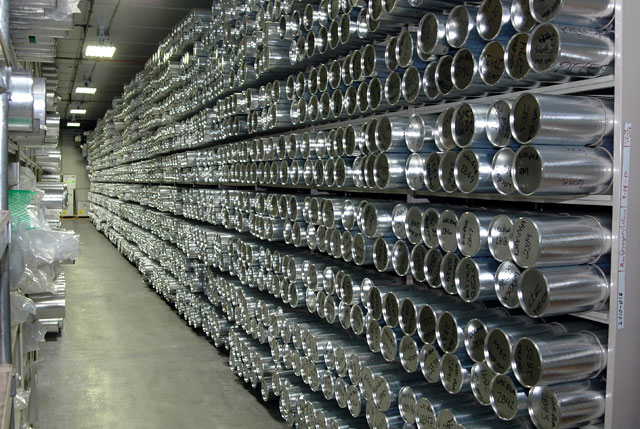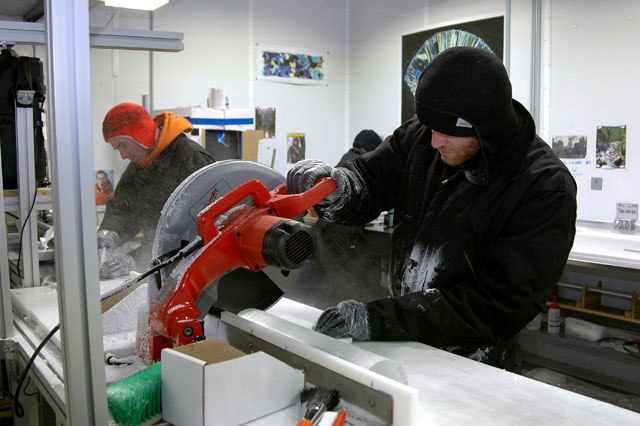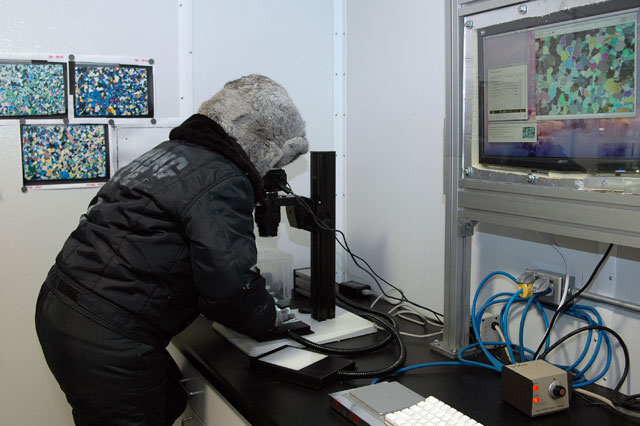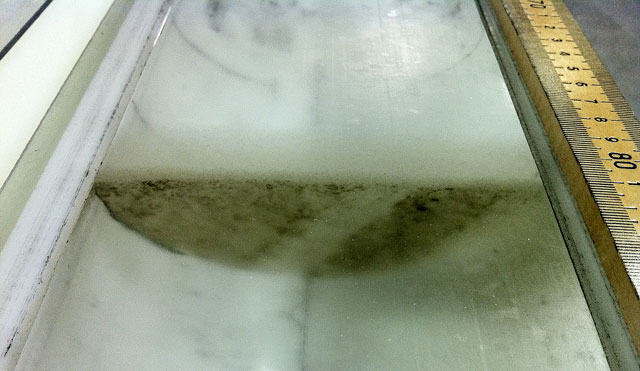Page 2/2 - Posted September 2, 2011
Processing iceBut first, all of the ice has to pass through NICL, a facility managed by the U.S. Geological Survey NICL staff and scientists (many of them students) from the labs collaborating on the WAIS Divide project spent most of the summer processing more than 1,300 meters of ice. A team processed a similar amount of ice from WAIS Divide last year as well. [See related article: On the line.] The Antarctic ice had been flown from the field camp in West Antarctica by military cargo plane to McMurdo Station The CPL seems more like lumberyard than laboratory. Technicians and scientists operate various saws to carve out sections of ice for different sorts of analyses. For example, long sticks of ice will be melted for different chemical measurements covering 70 percent of the elements in the periodic table. 
Photo Credit: Peter Rejcek
The WAIS Divide ice core boxes occupy this entire side of the aisle in the NICL freezer.
The chemistry can reveal information about past conditions such as sea ice extent, the amount of dust in the atmosphere and even seasonal changes, which reveals clues to the environmental conditions of the time. Results are still months, if not years, away for some of the project’s biggest science goals, according to Taylor. “The ice that we’re cutting today won’t be sampled by labs for a year, two years. We have so much ice right now,” said Taylor. Drilling deeperAnd there’s still more ice to come. Researchers plan to return to West Antarctica in 2011-12 to extract up to 100 more meters of cores. They will stop 50 meters away from the bottom of the ice where they expect there is a thin layer of meltwater on top of rock. The 50 meters of ice they leave behind will prevent contamination of the pristine water. However, ice that deep starts to do strange things. In the last couple of hundred meters, the team started to detect irregular flow patterns in the ice, which make the record a bit fuzzy. “At some point as you approach the bed, every ice core will start to show disruption in the stratigraphy. It can’t be helped, because the drag is so significant at the bed, whether it’s frozen to the bed or not,” explained Joan Fitzpatrick A few weeks before the final core was processed, the CPL team noticed some irregular flow in sections of the core as it passed below 3,000 meters, including dramatic slopes in visible ash layers, likely from ancient volcanic eruptions. To further investigate the severity of the irregularities, Fitzpatrick cut thin sections of the core to analyze the individual grains to see if their orientations have changed. The illumination system she uses makes the thin sections look like colorful kaleidoscope images. If the grains are in a different orientation, Fitzpatrick said, then “you know you have some significant stratigraphic disruption going on and all bets are off.” However, more recent discussions among the team following the CPL and after examining the evidence has encouraged the researchers that going deeper would be worthwhile. Replicating dataA new type of instrument called a replicate coring drill is being created by the engineers at the Ice Drilling Design and Operations (IDDO) Researchers are especially keen to examine abrupt climate changes in the past, especially the transition from the last ice age to the current warm period. The gas measurements by Brook and others often require large volumes of ice, so additional samples at different depths will be very useful. 
Photo Credit: Anais Orsi
An ice core sample melts under vacuum to release the ancient air bubbles for isotopic analysis at a lab.
“We are collecting quite a bit more gas samples than previous ice core projects, and the reason for that is that we’ve learned there’s a lot of information to be obtained from gases at this high resolution,” Brook said. The gas record is so important, particularly the CO2 data, that the team cutting ice for those measurements purposefully avoids sections of the core that show high dust concentrations. Dust in the core can interact with acids in the ice and release CO2 in situ, skewing the data. That’s why cores from Greenland, which is surrounded by land in the Northern Hemisphere, aren’t as a reliable source for past carbon dioxide concentrations in the atmosphere. That’s another reason for the high hopes surrounding the WAIS Divide ice core. “We are going to get a record of greenhouse gases that extends back 40,000 years, with the highest possible time resolution. The record will be used to test and improve the computer models that are used to determine the extent that human activity is influencing climate. It is great to be part of this team,” Taylor said. For a complete list of all NSF-funded projects related to WAIS Divide, see the WAIS Divide webpage of funded projects
|



For USAP Participants |
For The Public |
For Researchers and EducatorsContact UsU.S. National Science FoundationOffice of Polar Programs Geosciences Directorate 2415 Eisenhower Avenue, Suite W7100 Alexandria, VA 22314 Sign up for the NSF Office of Polar Programs newsletter and events. Feedback Form |




